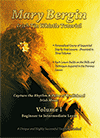
MARY BERGIN - The Irish Tin Whistle Tutorial
Private Label ISBN: 9780956299116
The long standing stylist of the most-popularly-taken-up instrument of traditional music on these islands has at last committed her secrets to print. This three-volume, text and audio production is a series of detailed lessons graded from the most simple to complex. It is not the first such publication, but it is a landmark one, for it is rare that the compiler would be both an accomplished performer and equally-accredited teacher who can thereby explain how she does what she does. In this ‘method’ she patiently breaks down and details the techniques which underlie the sparkling brilliance of her albums, particularly that on Feadóg Stáin which came out in 1979. Three books may seem daunting for what is the cheapest and (visibly) most simple of instruments, but one must consider that the melodic devices and repertoire which apply to whistle are in fact quite limitless, shared largely as they are with the concert flute and uilleann pipes.
The Irish Tin Whistle Tutorial has a huge amount of such data, supported aurally by in-cover CDs which have patient and exhaustive repetition: normal-tempo demonstration to ‘get’ the melody and rhythm, then slow to explore the detail – the next best thing to a master class, scores of which the teacher has given over her years of specialisation. The book reflects the by-now standard methodology which has arisen over the 40 or so years of such tutor development. But she strikes her own course too by presenting a personal modification of the ABC method of representing music to communicate elements of style. She breaks tunes down to their smallest rhythmic units - based on note groupings (in jigs, reels and hornpipes) rather than the standard-staff, time-signature-determined bars. In this way she can depict the use of performance technique such as breath-duration and ornamentation as part of ‘drive’ to ‘carry-over’ rhythm from bar to bar rather than have the music fragmented into isolated, uninteresting blocks. Her method accommodates phrasing too, as well as pulse (the use of carefully-chosen, breath-stop silences to ‘lift’ playing) and tonguing accent (to achieve sparkle). These are all key to achieving the desired traditional-music, unique sound as heard in any of the various regional and personal styles, particularly in that which she has pioneered herself.
Whether or not it is necessary to use any ABC to illustrate this when there is such a huge amount of aural material on the five CDs (and where her parallel use of staff notation conventions is perfectly clear) may be debatable, but this is her system and it has been successful in her local, national and international teaching of many hundreds of learners over the years.
One over-riding aspect of instruction in the books may be controversial. That is the indication of where to articulate in specified tunes: it may rankle with independent-minded players or those who decide not to use tonguing. But, as the title indicates, since this tutor is built as much on Mary Bergin’s reputation and unique style as it is about whistle playing, that is what will be highest on the priorities of those using it. And anyway, learning her style will not harm anyone, for it demands implementation of or awareness about the fullest potential and sophistication of this instrument.
Niggling aside, the tutorial is a most welcome addition to the whistle bibliography, for it is the most systematic yet. Coming from the mind and playing experience of such an outstanding professional musician and long-standing teacher, it is a rare, generous laying-bare and putting-on-the-analytical-record of expertise which is not only of itself valuable, but will also undoubtedly boost whistle-playing’s artistic status and popularity. It is important not least for clearly and valuably stating many normally-unspoken (but vital) ‘givens’. A major one of these is that Irish music is stylistically most tastefully played as ‘one long note’ which is broken up by decoration and technique in pursuit of the expression of style.
The tutorial has two volumes issued this far: the first with 92 pages, 44 tunes and 2 CDs, the second with 146 pages, 56 tunes and three CDs. Vol. 1 is complete as a total beginner’s resource and Vol. 2 carries this forward rapidly to facilitate a high level of development potential for a diligent learner. The contents are comprehensive, with ten major sections in each book broken down to patient sub-units, a modular structure which could be used in a different sequence where this was felt appropriate. Usefully too, since all music is clearly and methodically notated both in ABC and staff, both books could be successfully used by a teacher as a basis for structured group learning. And, since both have robust and accurate versions of terrific tunes, they are ideal sources for multi-instrument teachers and schools where common repertoire is desirable for group advancement. But it is the way in which each chapter sets out a fresh mission, works through that methodically, and concludes with a summary of what has been covered, that the tutorial promises that it will be of supreme value to its intended target - the individual whistle player. At €65-plus, these are books for the dedicated learner, but such is a modest fee for the huge potential in artistic expression and personal satisfaction that the skills which Mary Bergin demonstrates so ably can facilitate or release.
www.maryberginwhistle.com
Fintan Vallely
| Buy
this CD online from The Listening Post The Listening Post is the CD mailorder service of The Living Tradition magazine. This album was reviewed in Issue 100 of The Living Tradition magazine. |

